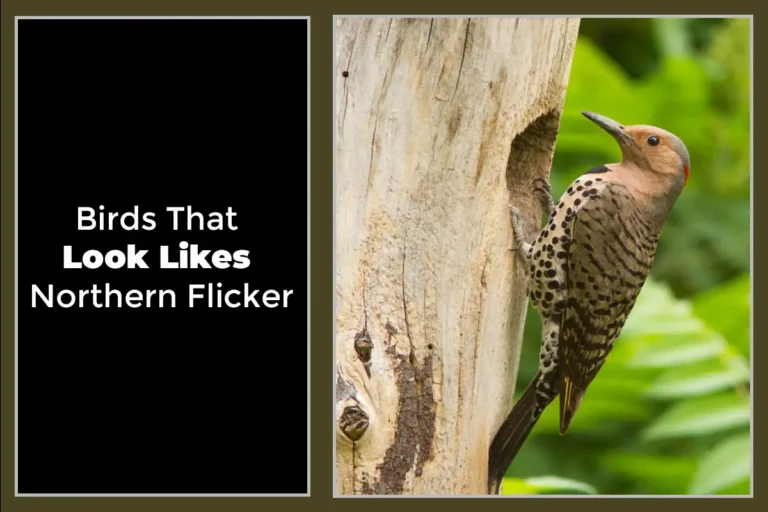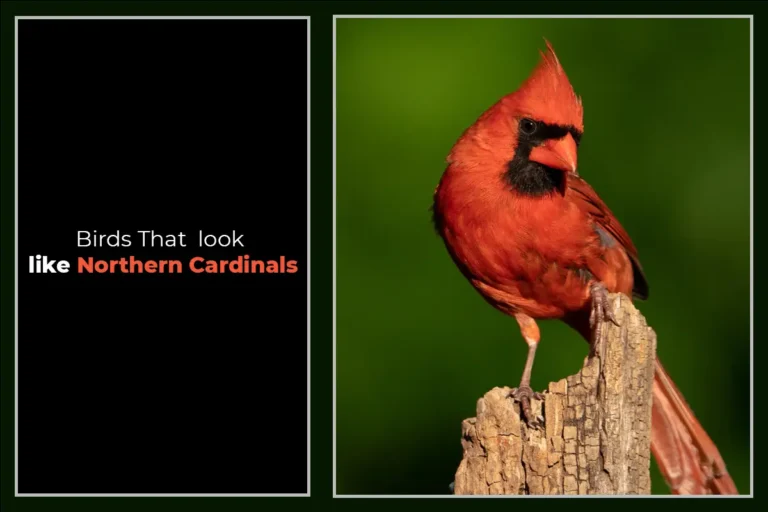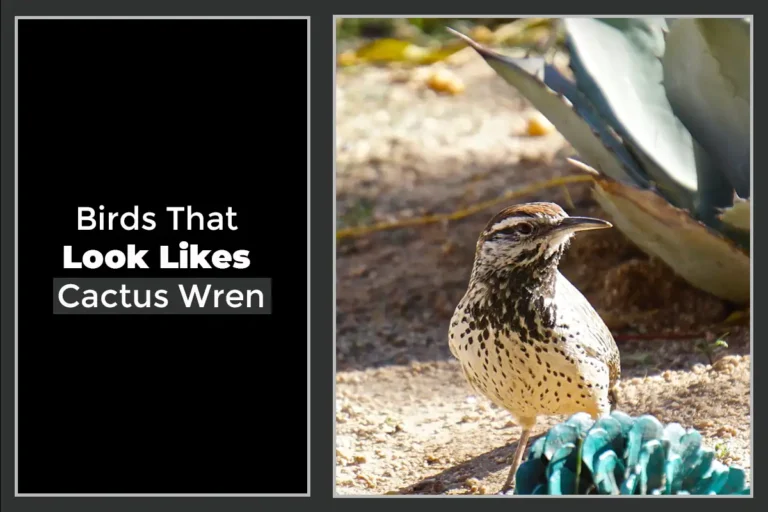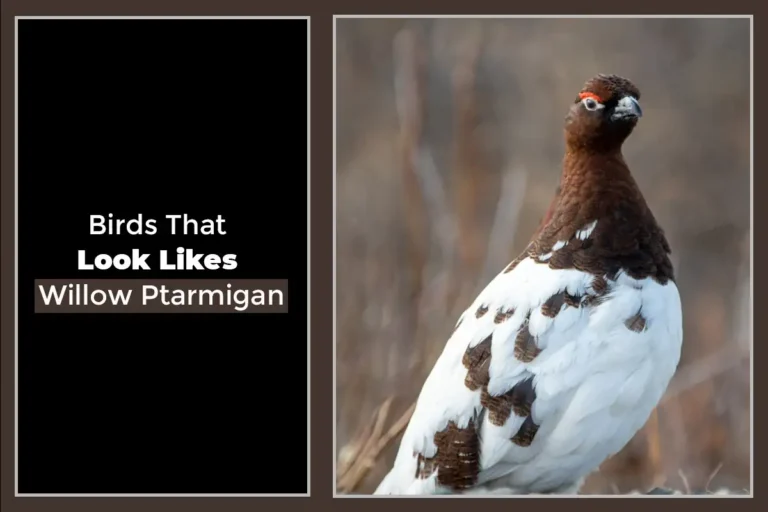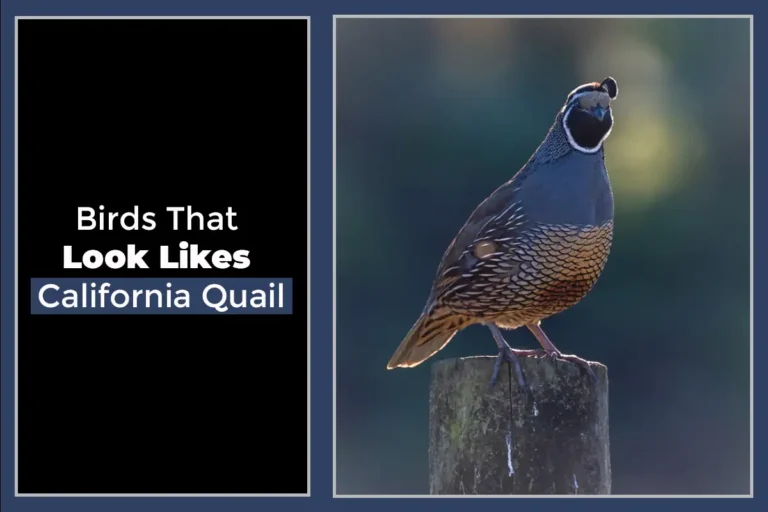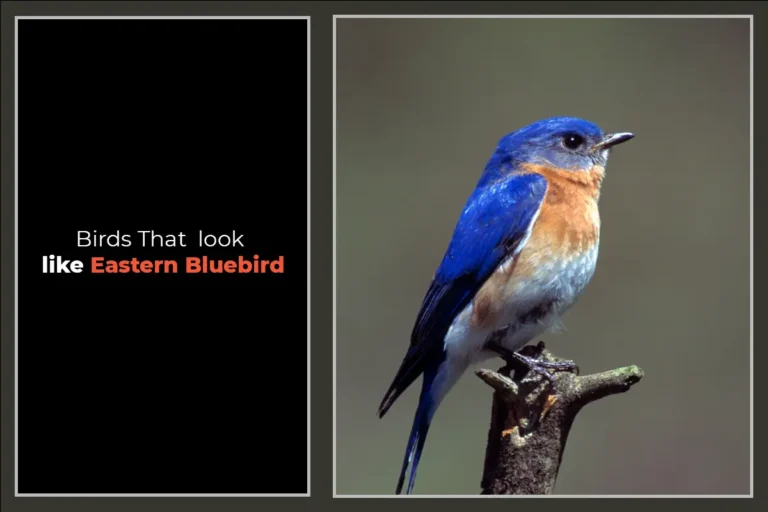10 Birds That Look Like American Robins
You catch a flash of orange and gray and immediately think, “Robin!” After all, the American robin is one of the most recognizable and abundant backyard birds in North America. But we need to have a chat, friend.
Several imposter bird species closely resemble robins in color, proportion, behavior, and even habitat. And it’s shockingly easy even for seasoned birders to mix them up! Don’t fret – I’ll arm you with the skills to tell these fakers apart once and for all.
We’ll inspect sly look-alikes, then masters of disguise copying Robin’s ways. Finally, ID tips to not be fooled again. Ready to spot the real Robin? Let’s solve this case!
Looking for more articles about similar birds:
Table of Comparison
| Bird | Physical Appearance | Behavior | Habitat | Distinguishing Traits |
|---|---|---|---|---|
| American Robin | Gray-brown back, rusty orange breast, black head | Forages on the ground eat worms/insects | Open woodlands, parks, and backyards | White patch around eyes |
| Spotted Towhee | Black back, white belly, rusty sides | Forages by scratching leaves | Thickets, brushy areas | White belly, red eyes |
| Varied Thrush | Dark gray/brown back, bright orange breast | Forages on the ground eat insects | Coniferous and mixed forests | Orange stripes over the eye and on the wings |
| Eastern Towhee | Black back, rusty sides, white belly | Scratches leaves looking for food | Forest edges, trails, urban parks | Orange stripes over the eye and on wings |
| Orchard Oriole | Black back, orange underside | Eats insects and fruits | Orchards, open woodlands | Smaller size, black bill |
| Red-breasted Nuthatch | Blue-gray back, rusty breast | Hops along branches and trunks | Conifer forests | Small size, striped head |
| Black-headed Grosbeak | Cinnamon, black and white body | Eats fruits/seeds, some insects | Parks, streamside woods, towns | Thick conical bill |
| Hermit Thrush | Brown back, spotted chest | Forages among forest floor litter | Mature moist forests | Brown back, no orange breast |
| Common Redstart | Gray back, orange underside, white forehead | Catches insects from foliage | Deciduous/mixed forests | Constantly fans vivid orange tail |
| American Redstart | Dark gray back, bright red/orange patches | Catches flying insects | Orchards, woodland edges | Smaller size, streaked orange wings |
Top Physical Trait Confusers
Alright, time to reveal the little secrets of Robin imposters! We will start by examining doppelgängers that nearly mimic the American robin’s signature look. I’ve divided them into categories based on sneaky similarities:
A. Colors
These scammers sport the classic robin colors but differ at second glance:
01. Red-breasted Nuthatch
Don’t let the name fool you – these petite charcoal and white songbirds aren’t thrushes at all.
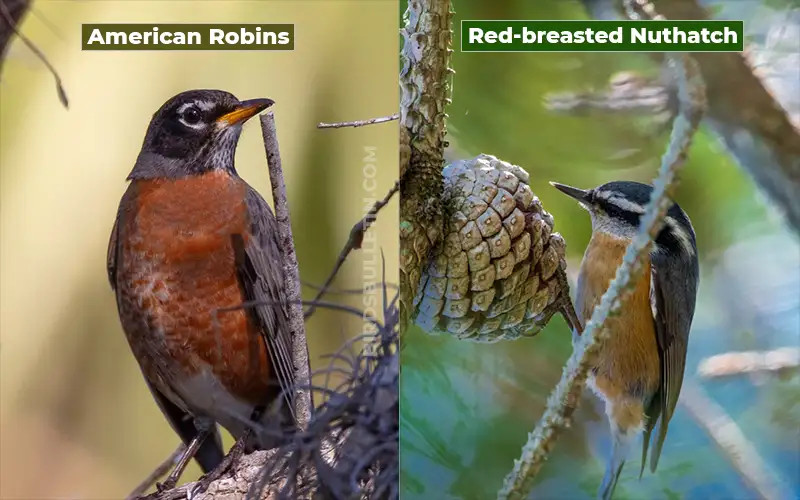
But male red-breasted nuthatches flaunt rusty undersides bright enough to compete with robins.
- Similar-sized white spots encircle both birds’ eyes. But while robins sport all-black backs, nuthatch wings flash powder blue.
- This Raymond Chandler detective sports a long, dagger-like bill for poking into pines versus the robin’s wider, yellow model.
- You’ll never catch a nuthatch on the ground! They spend their days headfirst scurrying down trunks.
02. Spotted Towhee
West Coast residents, beware this Robin impersonator! The male spotted towhee shares the same inky black mantle and orange sides as his eastern cousin.

But unlike the Eastern towhee’s rufous bib, his breast is bright white. Plus towhees rock sizzling red eyes.
Key evidence:
- White belly
- Red eyes
- Rusty sides instead of continuously colored breast/belly
03. Eastern Towhee
Speaking of the Eastern towhee, his sooty feather cape and tawny vest scream Robin cosplayer. But this bush bird doesn’t bare his belly – his rusty robe wraps all the way around. And he flashes white tail feathers like a tuxedo shirt when he flies.

Oh, and Mrs. Towhee? Completely incognito in her modest brown gown!
B. Size & Shape
You’d think impish frames or obese figures would keep these posers from posing. Think again! Let’s discuss dead ringers in robin garb:
04. Black-headed Grosbeak
Male black-headed grosbeaks will stop you in your tracks with their robin-esque getups. Sporting chocolate masks and wings with massive tangerine chests and bellies, they resemble overgrown, brawny robins.
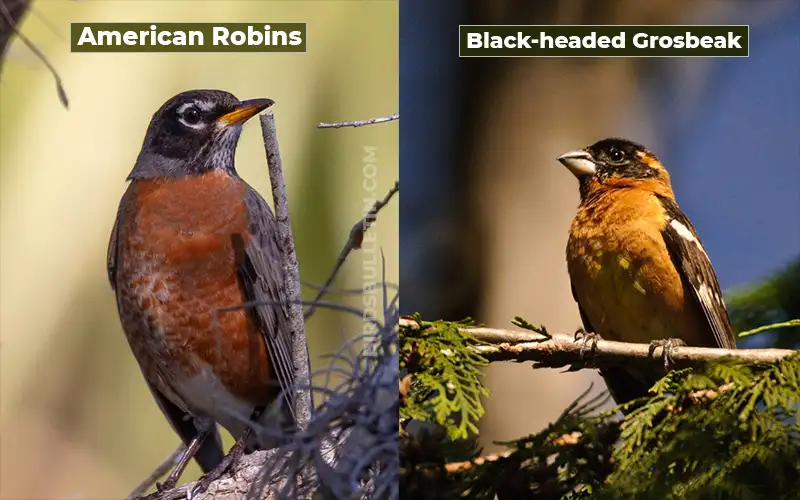
Until they spread their black and white speckled wings – no Robin boasts that kind of jazz!
- Larger, cone-shaped grey beaks.
- Bright yellow “armpits”
- Shorter tails
05. Varied Thrush
This Zorro bandit blending into northwest forests wears a black cape across its breast rather than up top.

But the varied thrush’s eye and nape streaks scream Robin!
- Stockier frames covered in scaling instead of feathers
- Vibrant, almost neon orange breasts
- Brown, rounded wings lacking white markings
06. Orchard Oriole
The male orchard oriole follows the “tiny robin” dress code with a tight-fitting ginger underside. But identical glowing oranges and slender ribbons of black down both sets of eyes set them worlds apart!
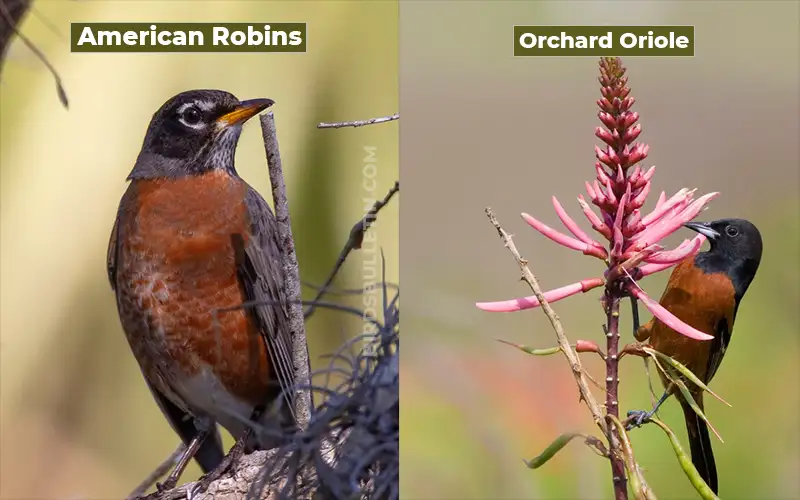
Plus Mrs. Orchard Oriole rocks a chartreuse cocktail dress – talk about a disguise! Her hazel eyes still give her away.
Behavioral Mimics
Alright, we’ve covered fakers copying Robin’s killer combo of orange, black, gray, and white.
Now for subtle impersonators that act like robins thanks to shared habitats and food sources. Let’s explore their strategies to blend in:
A. Foraging
These two have the robin’s worm-pulling, ground-foraging habits down pat!
07. American Redstart
It’s tough not to mistake a fluttering American redstart for an airborne robin with its tawny blazing underside exposed mid-flight!

- But this warbler frequents loftier branches versus down low, scarfing spiders and insects from leaves with its needle-like beak versus soil-dwelling goodies.
- Plus, the brassy blaze doesn’t stop – it streaks down slim wings and a splayed tail in arresting patterns.
- Redstarts announce their arrival with emphatic “chit chit chits” versus the robin’s whistles.
- You’ll never spy a fully red-bellied redstart; their white bellies always give them away.
08. Hermit Thrush
Hermit thrushes sticks to forest floors, blending into leaf litter perfectly with their spotted chests mimicking dappled sunlight. You’ll swear you’re seeing a juvenile robin teetering on a branch!
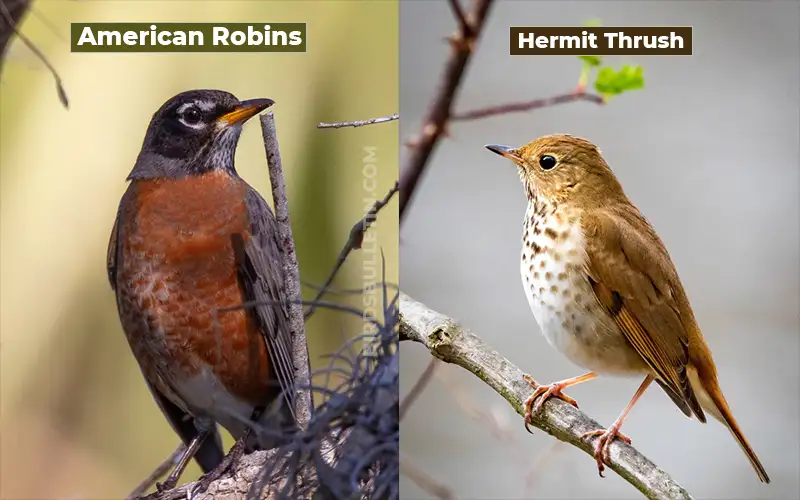
But their idyllic flute songs – one of the most beautiful of all birds – will give them away every time. Plus:
- Smaller than robins with warm brown backs
- Lacks vivid orange – more of a pale peach bib
- Bold eye ring
B. Habitat & Migration
Think leftover fall and winter robins simply stay put as the fair-weather variety heads south? Think again! Imposters casing your yard include:
09. Common Redstart
Common redstarts share the robin’s winter habitat but rock more vibrant bonfire bellies and inky caps than tired old snowbirds.
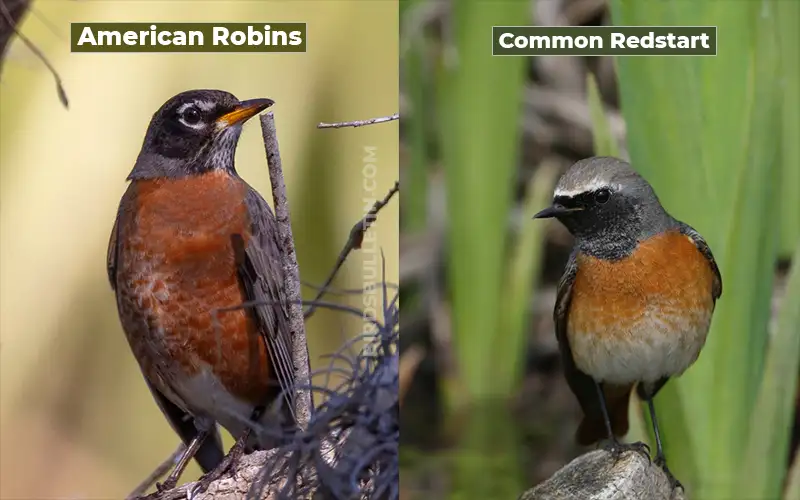
Their namesake ruddy tails confirm the ID.
Questions to ask:
- Are its legs black too? → Redstart
- Is the underside fully red? → Robin
- Does it constantly fan that foxy tail? → Redstart
10. Male Spotted Towhee
You’re raking leaves when a portly spotted towhee darts furtively from shrub to shrub. Aha, a late-migrating robin!
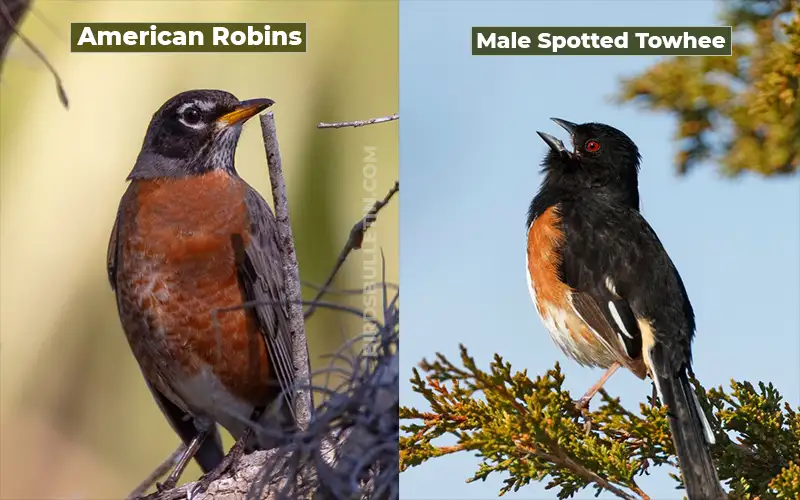
But towhees stick around all winter, scraping leaf litter beneath thorny brush for leftover seeds and fallen berries. Plus, this guy has tell-tale:
- White spots on rusty wings
- A slightly longer, jet-black bill than the Robin
- Blood-red eyes
Expert Tips for Proper Identification
By now, your eyes are honed to catch subtle distinctions between robins and their expert impersonators. Let’s reinforce key ID points so you cement that tricky trivia for good!
I’ll break it down into physical traits versus behavior since tricky imposters blend in both ways.
A. Field Marks
When a bird’s silhouette alerts you to a robin, cross-check:
Plumage Patterns
- Orange intensity: Is that rusty bib neon orange or a more muted terra cotta? Vibrant shades signal lookalikes.
- White spots: Check wings and tails for contrasting spots. Towhees and thrushes sport markings.
- Facial features: The perfect circle of white around a robin’s eye is iconic. Also, check for eyerings or stripes.
Bill Color
- Robins sport all yellow bills versus black or grey imposter beaks. The shade also differs – robin beaks match dandelions.
- Bill shape counts too – thickness, hook curve, spear-like points. Study subtle variations.
Eye Color
Robins have almost black eyes while red or hazel eyes** belong to mimics like towhees and female orchard orioles.
B. Behavioral Differences
If a bird passes the visual check, observe behavior before confirming your ID:
- Foraging style: Robins use beaks to overturn ground debris. Do you see rapid leaf gleaning or hovering to catch insects?
- Migration: Snowbird robins appear tired with ruffled feathers. Imposters like redstarts pop brighter against white landscapes.
- Vocalizations: The robin’s cheerful song is instantly recognizable. Learn the variety of sweets, chips, and calls of copycats.
- Tail positions: Species like redstarts frequently cock or fan their tails; robins do not.
Keep these physical and behavioral clues handy as you monitor activity. Soon Robin fraudsters can’t escape your scrutiny!
Wrapping Up
Congrats, friend – you now possess the power to differentiate between American robins and their trickiest impersonators! We covered sneaky lookalikes in colors and proportions plus behavioral copycats that mimic robin habitats and feeding.
With so many birds angling for robin status, staying sharp is key. Keep this intel handy as you monitor activity in your yard and surrounding areas. Soon you’ll instinctively notice giveaway traits allowing for quick bird IDs.


